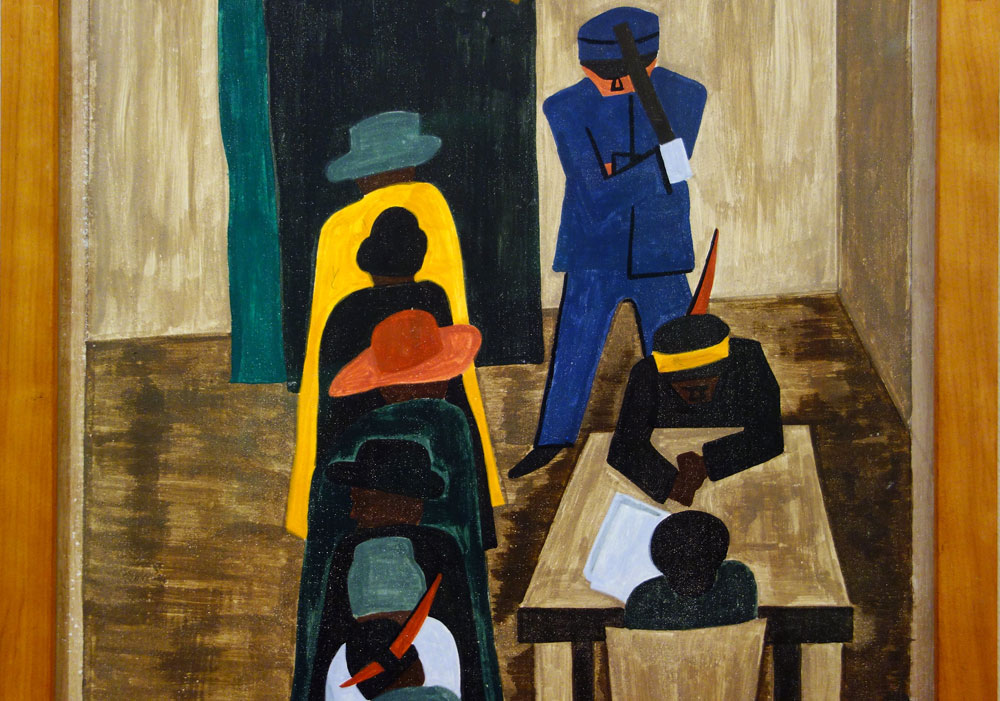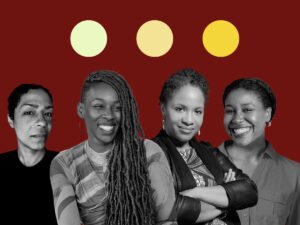
Each of us is in a container of some kind. The label signals to the world what is presumed to be inside and what is to be done with it. The label tells you which shelf your container supposedly belongs on. In a caste system, the label is frequently out of sync with the contents, mistakenly put on the wrong shelf and this hurts people and institutions in ways we may not always know.
~ Isabel Wilkerson, Caste: The Origins of Our Discontents
This article is the third in a series of personal essays that NPQ, in partnership with Tony Pickett of the Grounded Solutions Network and Marcus Littles of Frontline Solutions, is publishing in the coming weeks. Titled Black Male Leadership: Nonprofit Voices, Truth, and Power, the objective of this series is to lift up Black male voices to highlight the challenges facing Black male leaders in the nonprofit sector, as well as the sector as a whole, amid ongoing anti-Black violence and the disparate racial impact of COVID-19. You can read prior entries here and here.
During my childhood, it was commonplace for adults and older youth to preface either a chide or pearl of conventional wisdom with the phrase, “Black men don’t do….” My early sense of racial and gender identity was informed by profound racial group pride in Black community progress braided with social conservatism rooted in southern, Black Christian traditions. This orientation to the world presents paradoxes that shape limiting informal rules for socially permissible behaviors.
For example, Black men working outside the home was socially accepted, while performing care or housework was the domain for women, most of whom also worked outside the home. These constraining norms, if adhered to, would simultaneously affirm heterosexual maleness and, unapologetically, advance racial pride. Conversely, thoughts and behaviors outside the convention of Black male do’s and dont’s could lead to, at least, unyielding teasing and, at worst, intimidation and violence. In a perverse way, the intent and reinforcement of these norms was to “strengthen you against the loveless world,” James Baldwin aptly references in The Fire Next Time.
In practice, these norms often have the opposite effect; for some Black people, they mirror the oppressive experiences of navigating predominantly white contexts. The subjugation of individuality in favor of the perceived collective good can unintentionally exclude people. The marginalization and erasure of difference and diversity is oppressive and, similarly, can lead to othering people. The assignment of individual or group achievement to socially constructed labels unduly relegates human potential to the imagination of its architects. These social dynamics do not inspire freedom; instead they help maintain the status quo. Fortunately, there are more loving ways to equip each of us with the confidence and resilience needed to thrive.
The nonprofit sector is seemingly holding firm to its own set of obdurate norms and expectations based on identity. Along with others, this publication has well-documented the sector’s tribulations with predominantly white and male executive staff and board leadership throughout the sector at well-established and more recently emergent fields alike. Rather than regurgitate readily available information on the challenges of diverse and inclusive nonprofit leadership, I encourage reading the insightful works cited here. It is worth noting that according to available data, Black men are woefully under-represented among the executive and board leadership of this sector. Instead, I’ll use this space to be solutions-oriented.
Like the nation, the nonprofit sector faces a reckoning with its own progress, or lack thereof, confronting historical and contemporary manifestations of a social ordering that allocates opportunity, privilege, and power based on race. Over the last 15 years, and more intensely in 2020, leading voices for diversity, equity, and inclusion have been amplifying calls for executive leaders and boards to address the churn effect—overall absence, turnover, lack of mobility, and departure from the sector—of Black and POC [people of color] professionals across the industry.
Sign up for our free newsletters
Subscribe to NPQ's newsletters to have our top stories delivered directly to your inbox.
By signing up, you agree to our privacy policy and terms of use, and to receive messages from NPQ and our partners.
As we are witnessing in technology, advertising, and other industries, the nonprofit sector needs to raise the ante on its commitment to additional investments in sustaining diversity and inclusion. Such general measures could include producing reliable and up-to-date demographic information to enable tracking and monitoring of progress on diversity and inclusion efforts, building pathways into executive leadership, crafting culturally appropriate retention strategies, creating welcoming organizational cultures, developing resources and supports for first-time executive leaders, and, importantly brokering introductions to influential networks and people.
For Black men, some specific steps might improve their recruitment, retention, and mobility in the sector. The list below details some of these themes. It is a compilation of original ideas and adapted suggestions from diversity and inclusion advocates, with attribution.
- Recruit and coach Black male interns and fellows from historically Black colleges and universities (HBCUs) and Predominantly White Institutions (PWIs) and pair them with professional coaches to add more diverse talent to the philanthropy pipeline and support their acclimation to the sector.
- Use your privilege to affirm the voices of the Black men and women. When a Black person shares a good idea in a meeting, repeat it and credit them properly. Even when your views differ, affirm the importance of their contribution to moving the conversation forward.
- Be honest about bias by taking a look at your organization’s rate of hiring and promoting Black men and women. Analyzing their progress helps you see if you are creating a diverse leadership bench.
- Lead by example and mentor Black men and women by sharing your knowledge, demonstrating behaviors, and talking about the performance habits that lead to success in your organization and the sector.
- Check in regularly with Black men and women in your organization to build professional rapport rooted in mutual accountability. This will also help build trusting relationships and reinforce an inclusive workplace culture.
Sean Thomas-Breitfeld and Frances Kunreuther, Co-Directors of the Building Movement Project and co-authors of Race to Lead Revisited, offer a complimentary set of recommendations:
- Focus on Structures and the Experience of Race and Racism. Structural analysis of race and racism, especially for white-dominant groups, is a critical foundation for race equity work. However, focusing on structural racial issues will only be meaningful if coupled with efforts to understand and validate the individual and collective experiences of people of color in nonprofit organizations and institutions.
- Policies Have Meaning…If Enforced. It is essential to consistently model and reinforce the organization’s commitment to racial equality. A realignment of policies and practices is only effective if they are acted on consistently and universally.
- Put Your Money… Organizations led by people of color simply need more funding. [Funding to these groups is] even more critical as organizations led by people of color, which have smaller budgets on average than those led by white people, manage financial losses due to the COVID-19 pandemic that also disproportionately affects communities of color.
- Reflect the Community: Racial Diversity in Action. Recruiting and retaining racially diverse staff and board leaders requires setting and meeting targets for bringing on candidates, instituting effective onboarding and support for new staff and board members, and being willing to shift power—that is, to listen to the observations and recommendations of staff and board members of color, and to change the organization’s policies and practices accordingly.
- Responsibility and Results. Diversity, equity, and inclusion requires ongoing commitment and investment. This includes establishing thoughtful ways to assess progress based on a widely shared plan for what should change, who is responsible, and how results will be documented. Transparency of results and organization-wide annual reviews can help guide course corrections and ongoing goals.
Closing Reflections
The public health and economic crisis instigated by COVID-19, combined with the existential threat posed by severe climate change and this moment of racial reckoning, are establishing new social, economic, and health expectations. As new realities mandate adaptation, we need to shed old mental models that assign societal value and opportunity based on identity and social standing.
Advancing Black male leadership in the nonprofit sector could mean, at a minimum, holding executive and middle managers accountable for their professional development and retention. Early in my career while working in nonprofits and foundations, I was lucky to have mentors who invested time to share wisdom, answer questions, and offer career advice. Career success for Black men in the sector should not hang on the altruism of a few generous colleagues. Our sector can and should be better at recruiting, hiring, retaining, and promoting the Black men who are often the intended beneficiaries of philanthropic grants and nonprofit services.
Like our peers in the sector, Black men possess agency that can be exercised to build networks, seek out mentors, and build new competencies among steps to advance their careers. Dissimilar from our peers, the sector can feel unwelcoming to Black men, particularly in leadership roles. The sense of being unwelcome shows up in small ways, like being omitted from spaces of influence where networks can be developed, to the gross underrepresentation of Black men in C-suites and at Board tables.
Certainly, many Black men find our way despite the obstacles. I have personally done so—with the time, support, and sage guidance of others, meshed with my own grit and resilience. However, making our way is still overly dependent on escaping the assumptions that too often hold many of my talented colleagues back. Clearly, more purposeful effort is needed to increase Black men’s access to networks, professional coaches/formal mentorship, and relationships to power and influence.
The steps for achieving this shift are largely known—indeed, I have listed 10 of them above in this article. The key, however, is to commit to implementing them.













